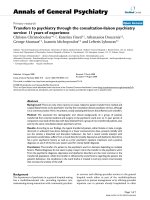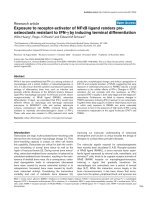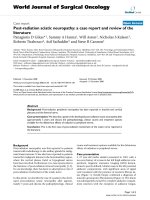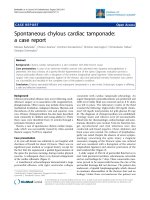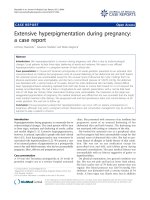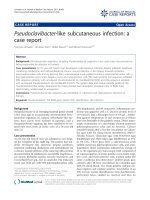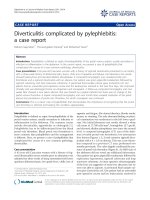Báo cáo y học: " Hypersensitivity to intravenous ondansetron: a case report" ppsx
Bạn đang xem bản rút gọn của tài liệu. Xem và tải ngay bản đầy đủ của tài liệu tại đây (186.55 KB, 3 trang )
BioMed Central
Page 1 of 3
(page number not for citation purposes)
Journal of Medical Case Reports
Open Access
Case report
Hypersensitivity to intravenous ondansetron: a case report
Karishma K Mehra
1
, Nithya J Gogtay*
1
, Rohan Ainchwar
2
and Lata S
Bichile
2
Address:
1
Department of Clinical Pharmacology, Seth GS Medical College & KEM Hospital, Parel, Mumbai, 400012, India and
2
Department of
Medicine, Seth GS Medical College & KEM Hospital, Parel, Mumbai, 400012, India
Email: Karishma K Mehra - ; Nithya J Gogtay* - ; Rohan Ainchwar - ; Lata S
Bichile -
* Corresponding author
Abstract
Introduction: Ondansetron, a 5-hydroxytryptamine
3
receptor antagonist widely used in the prevention
and treatment of chemotherapy-induced nausea and vomiting, is associated with various unusual adverse
drug reactions. In this paper, we describe a hypersensitivity reaction to a single intravenous dose of
ondansetron.
Case presentation: A 19-year-old woman presented to the emergency department of our institute with
3–4 episodes of nausea, vomiting and epigastric distress. She had a diagnosis of polycystic ovarian disease
and had been on treatment with cyproterone acetate 2 mg, ethinyl estradiol 0.035 mg, finasteride 5 mg
and metformin 500 mg for a month. She had been taking oral roxithromycin 500 mg per day for the past
3 days for treatment of a mild upper respiratory tract infection. She also occasionally took rabeprazole 10
mg for gastritis which had worsened after treatment with roxithromycin. She was treated with a single 4
mg dose of ondansetron intravenously. She immediately developed urticaria, which was treated with
intravenous dexamethasone 4 mg and chlorpheniramine maleate 20 mg. The reaction abated within a few
minutes and she was discharged within an hour. She was asymptomatic at 72 hours of follow-up.
She had no history of ondansetron exposure, or drug or food allergies. On the Naranjo's causality
assessment scale, the adverse event was 6 indicating a "probable" reaction to ondansetron.
Conclusion: 5-hydroxytryptamine
3
receptor antagonists have been associated with life-threatening
adverse reactions such as hypotension, seizures and anaphylaxis. The wide availability of these drugs in
India has promoted their off label use in the treatment of gastritis, migraine and so on. Our case represents
an off label use in a patient who could have been treated with a safer drug.
Some authors have suggested that anaphylaxis may be a class effect while others think it may be drug
specific. In our case, the reaction could be either anaphylaxis or anaphylactoid, but the latter seems more
likely given the history of absence of prior sensitization. Other components of the drug, such as solvent,
also need to be considered as a cause of this reaction. Considering all of the existing evidence, we need
to be more cautious while using ondansetron and also to be aware of the various unusual side effects,
especially when used in an out-of-hospital set-up.
Our case report underscores the importance of physicians judiciously using the drug, particularly in the
outpatient setting so as to reduce the incidence of avoidable adverse drug reactions.
Published: 14 August 2008
Journal of Medical Case Reports 2008, 2:274 doi:10.1186/1752-1947-2-274
Received: 21 January 2008
Accepted: 14 August 2008
This article is available from: />© 2008 Karishma et al; licensee BioMed Central Ltd.
This is an Open Access article distributed under the terms of the Creative Commons Attribution License ( />),
which permits unrestricted use, distribution, and reproduction in any medium, provided the original work is properly cited.
Journal of Medical Case Reports 2008, 2:274 />Page 2 of 3
(page number not for citation purposes)
Introduction
Ondansetron is a 5-hydroxytryptamine
3
(5-HT
3
) receptor
antagonist widely used in the prevention and treatment of
chemotherapy-induced nausea and vomiting, especially
caused by highly emetogenic drugs such as cisplatin, and
is considered a gold standard for this purpose [1]. It may
also be used in the prevention and treatment of radiation
induced nausea and vomiting as well as post-operative
nausea and vomiting. Commonly seen side effects include
constipation or diarrhea, headache and dizziness. All 5-
HT
3
receptor antagonists have been associated with
asymptomatic electrocardiogram changes, such as prolon-
gation of the PT and QTc intervals and certain arrhythmias
[2]. The clinical significance of these side effects is
unknown. Hypersensitivity to ondansetron is a rare side
effect. In this paper, the authors describe a case of hyper-
sensitivity to a single intravenous injection of ondanset-
ron.
Case presentation
A 19-year-old female patient visited the emergency
department (ED) of a tertiary referral center with 3–4 epi-
sodes of nausea, vomiting and epigastric distress. She had
been diagnosed with polycystic ovarian disease (PCOD)
and had been on treatment with cyproterone acetate 2 mg,
ethinyl estradiol 0.035 mg, finasteride 5 mg and met-
formin 500 mg for one month. The patient had also been
taking oral roxithromycin 500 mg per day for the past 3
days for treatment of a mild upper respiratory tract infec-
tion. The patient also occasionally took a single dose rab-
eprazole 10 mg for gastritis. The gastritis had worsened
after treatment with roxithromycin which was the cause of
her visit to the ED. She was treated with a single 4 mg dose
of ondansetron intravenously. Within a few seconds, the
patient developed redness and wheals around the injec-
tion site along with urticaria. There was no hypotension or
bronchospasm. She was immediately treated with intrave-
nous dexamethasone 4 mg and chlorpheniramine
maleate 20 mg. The reaction abated within a few minutes.
The patient did not complain of any other symptoms and
was discharged after an hour of observation. She was
asymptomatic at 72 hours of follow-up.
On further history taking, the patient gave no previous
history of use of ondansetron or other 5-HT
3
antagonist
exposure, and no drug or food allergies. There was no his-
tory of a similar episode in the past. She gave no personal
or family history of atopy, asthma or bronchitis. On the
Naranjo's causality assessment scale, the adverse event
was 6 indicating a "probable" reaction to ondansetron [3].
Discussion
5-HT
3
receptor antagonists such as ondansetron, tropiset-
ron, granisetron and palonosetron are generally associ-
ated with a wide safety margin and are widely used in
cancer chemotherapy. There are, however, reports of life-
threatening adverse events such as generalized tonic
clonic seizures, hypotension [4], chest pain and dystonia
[5]. To date, all anaphylaxis and anaphylactoid reactions
induced by ondansetron have been in patients receiving
the drug for cancer chemotherapy. This has prompted
some authors to suggest that the drug's use should be
restricted [6]. In the Indian market, the drugs have a wide
availability with over 43 different brands. [2]. The wide
availability of this class of drug has promoted the off label
use of these drugs, such as in the treatment of antimalar-
ial-induced vomiting, gastritis, migraines and other eme-
togenic conditions. The present case also represents the
off label use of the drug in a patient who could have prob-
ably received safer medication such as domperidone or
metoclopramide.
Some authors have suggested that anaphylaxis may be a
class effect [7], while others think it may be drug specific
[8]. Ondansetron and tropisetron share an indole hetero-
cycle, while granisetron does not. This may justify the
reports contradicting anaphylaxis as a class effect. While
anaphylaxis is IgE mediated, anaphylactoid reactions are
non-immune mediated. We did not determine IgE levels
in this patient. A skin test was also not done, given the
serious nature of the reaction. Thus the reaction could
have been either anaphylaxis or anaphylactoid, but the
latter seems more likely given the history of absence of
prior sensitization. In 1993, Chen et al. reported that a
total of 24 cases of varying manifestations of anaphylaxis
or anaphylactoid reactions were reported to the United
States Food and Drug Administration [9].
In the wake of the above evidence, and the increasing
availability and off label use of ondansetron and other 5-
HT
3
receptor antagonists, we need to be more cautious
while using this drug and also to be aware of the various
unusual side effects, especially when used in an out-of-
hospital set-up where prompt treatment of the reaction
may not be possible. Our case report underscores the
importance of physicians judiciously using the drug so as
to reduce the incidence of similar avoidable adverse drug
reactions.
Conclusion
We emphasize the need to be judicious in the use of
ondansetron and five other HT
3
receptor antagonists due
to their association with various unusual and life-threat-
ening reactions. We also caution against the off label use
of the drugs, especially in an out-of-hospital set-up.
Consent
Written informed consent was obtained from the patient
for publication of this case report. A copy of the written
Publish with BioMed Central and every
scientist can read your work free of charge
"BioMed Central will be the most significant development for
disseminating the results of biomedical research in our lifetime."
Sir Paul Nurse, Cancer Research UK
Your research papers will be:
available free of charge to the entire biomedical community
peer reviewed and published immediately upon acceptance
cited in PubMed and archived on PubMed Central
yours — you keep the copyright
Submit your manuscript here:
/>BioMedcentral
Journal of Medical Case Reports 2008, 2:274 />Page 3 of 3
(page number not for citation purposes)
informed consent is available for review by the Editor-in-
Chief of this journal.
Competing interests
The authors declare that they have no competing interests.
Authors' contributions
KM identified the adverse drug reaction and wrote the first
draft of the paper. NG conceived the manuscript, per-
formed the literature search, did the causality analysis and
wrote the final draft of the paper. RA was the physician
who treated the adverse drug reaction. LSB helped to draft
and finalize the manuscript.
Acknowledgements
Dr. M. E. Yeolekar, Director, Medical Education & Health, Seth GS Medical
College & KEM Hospital, Parel, Mumbai (Bombay) 400012, India
References
1. de Wit R, Aapro M, Blower PR: Is there a pharmacological basis
for differences in 5-HT3-receptor antagonist efficacy in
refractory patients? Cancer Chemother Pharmacol 2005,
56(3):231-238.
2. Current Index of Medical Specialties. India: Oct 2007–Jan 2008 [Update
4] CMP Medica India Pvt. Ltd; 2008:191-193.
3. Naranjo CA, Busto U, Sellers EM, Sandor P, Ruiz I, Roberts EA,
Janecek E, Domecq C, Greenblatt DJ: A method for estimating
the probability of adverse drug reactions. Clin Pharmacol Ther
1981, 30(2):239-245.
4. Sharma A, Raina V: Generalised seizures following Ondanset-
ron. Ann Oncol 2001, 12(1):131-132.
5. Tolan MM, Fuhrman TM, Tsueda K, Lippmann SB: Perioperative
extrapyramidal reactions associated with Ondansetron.
Anesthesiology 1999, 90(1):340-341.
6. Frigerio C, Buchwalder PA, Spertini F: Ondansetron: reasons to
be restrictive. Lancet 1996, 347(9001):584-585.
7. Kataja V, de Bruijn KM: Hypersensitivity reactions associated
with 5-hydroxytryptamine (3)-receptor antagonists: a class
effect? Lancet 1996, 347(9001):584-585.
8. Bousquet PJ, Co-Minh HB, Demoly P: Isolated urticaria to
ondansetron and successful treatment with granisetron.
Allergy 2005, 60(4):543-544.
9. Chen M, Tanner A, Gallo-Torres H: Anaphylactoid-anaphylactic
reactions associated with ondansetron. Ann Intern Med 1993,
119(8):862.


